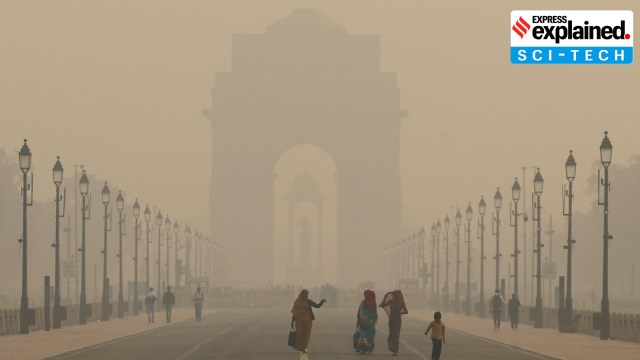To fix air pollution, Gopal Rai wants artificial rain in Delhi: Why this is a long shot
The average air quality index (AQI) in Delhi stood at 492 on Tuesday at 7 am. The AQI in Alipur, Anand Vihar, Bawana, Narela, Pusa and Sonia Vihar touched 500 — the maximum index according to the Central Pollution Control Board
 Women walk on a road near India Gate as the sky is enveloped with smog after Delhi's air quality worsened due to air pollution, in New Delhi, India, November 19, 2024. REUTERS/Anushree Fadnavis
Women walk on a road near India Gate as the sky is enveloped with smog after Delhi's air quality worsened due to air pollution, in New Delhi, India, November 19, 2024. REUTERS/Anushree FadnavisAs the national capital’s air quality continued to be in the ‘severe plus’ category for the third consecutive day, Delhi Environment Minister Gopal Rai wrote a letter on Tuesday (November 19) to the Centre seeking clearance for allowing artificial rain in the region. He also urged the Centre to convene a meeting with experts in IIT Kanpur and the Union government agencies regarding the matter.
The average air quality index (AQI) in Delhi stood at 492 on Tuesday at 7 am. The AQI in Alipur, Anand Vihar, Bawana, Narela, Pusa and Sonia Vihar touched 500 — the maximum value on the index according to the Central Pollution Control Board.
The choking air pollution has persisted in the region even as Stage IV of the Graded Response Action Plan (GRAP) kicked in on Monday (November 18). GRAP is a set of emergency measures implemented to prevent further deterioration of air quality once it reaches a certain threshold in the Delhi-NCR region.
So, can artificial rain, also called cloud seeding, fix Delhi’s air quality? Simply put, at best it can have a limited impact and result in several unintended consequences which can severely impact the environment. Here is why.
But first, what is artificial rain or cloud seeding?
Water vapour condenses around small particles to form the droplets that make up a cloud. These droplets collide and grow; as they get heavy and the cloud gets saturated, it rains.
With cloud seeding, clouds are usually injected with salts like silver iodide, potassium iodide, or sodium chloride, which is the ‘seed’. These salts are expected to provide additional nuclei around which more cloud droplets can form. They are dispersed into the cloud either using aircraft or through generators on the ground.
“Seeding accelerates cloud microphysical processes. You need sufficiently large droplets that can reach the surface of the Earth and not evaporate on the way,” Sachchida Nand Tripathi, Professor at IIT Kanpur and Steering Committee member, National Clean Air Programme, had told The Indian Express in 2023.
Tripathi had also said, “The substance that is dispersed into the cloud needs to have cloud condensation nuclei and ice nuclei and these two come from two different salts.”
The cloud condensation nuclei help form cloud droplets, and ice nuclei help to form ice crystals. Ice crystals grow faster than drops, and they become large and fall.
What are the conditions required for cloud seeding to be done?
Firstly, cloud cover and clouds of a certain type are necessary.
M Rajeevan, former secretary of the Ministry of Earth Sciences, had told The Indian Express, “Cloud seeding can only happen if there is a sufficient number of clouds and a particular depth to these clouds. Inside, there needs to be an adequate number of cloud droplets. Cloud seeding is done to increase the radius of the cloud droplets so that they will grow bigger and because of gravity, they will come down as rainfall. But with a clear sky, you can’t do it.”
In winter, clouds form over Delhi when a western disturbance moves over the region. These are storms that originate in the Caspian or Mediterranean Sea and bring non-monsoonal rainfall to northwest India.
With a stable atmosphere in winter, clouds are expected to form when a western disturbance disturbs this stability of the atmosphere.
“In winter, you do not see the kind of clouds that are needed for seeding, but western disturbances are the way through which clouds form. Even if clouds are there, you need to see what their height is, what their liquid water content is,” Tripathi had said.
While the possibility of cloud formation can be determined in advance through radars, other conditions will have to be studied on the day seeding is likely to be done.
Can cloud seeding or artificial rain fix air pollution?
Despite years of research on cloud seeding, the evidence of its effectiveness is mixed. In 2003, a study by the National Academy of Sciences — a US-based non-profit organisation — found “a high degree of uncertainty regarding the efficacy of cloud seeding”, according to a report by Bulletin of the Atomic Scientists.
The report also cited a recent synthesis by the World Meteorological Organization which had concluded that increased precipitation through cloud seeding typically ranges between zero and 20%, “with the upper range representing conditions under which clouds were highly likely to form precipitation naturally.”
In his 2023 article for The Indian Express, Aerosol scientist Shahzad Gani wrote that cloud seeding can only offer a temporary reprieve from air pollution at best.
Notably, pollutants such as PM2.5 and PM10 can be washed out to a significant extent by prolonged rainfall. However, other pollutants like ozone and sulphur dioxide are not affected.
Besides, cloud seeding or artificial rain can severely impact the environment. For instance, the chemicals used — such as silver iodide — in the process can adversely affect agriculture and the ecosystem if they accumulate in soil and water in large quantities. Scientists are yet to fully understand the impact of these chemicals on the environment.
There are also ethical concerns regarding cloud seeding, according to Gani. He wrote, “The water vapour used in the process would have naturally precipitated elsewhere, and it potentially deprives other regions of rainfall. This artificial manipulation of weather patterns could even lead to droughts in areas which would have received this rainfall otherwise.”
- 01
- 02
- 03
- 04
- 05






































